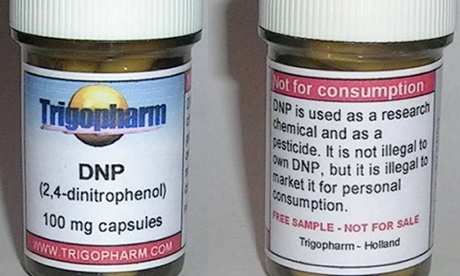
Four deaths in the UK and up to 60 worldwide have recently been attributed to the substance 2,4-dinitrophenol (DNP), an industrial chemical that has become popular among people wanting to lose weight, including bodybuilders and people with eating disorders.
The dangers of DNP were even raised in the House of Commons where David Cameron agreed to see what action could be taken to protect people. DNP is not, however, a new substance and its deadly effects have been known for nearly a century. Its history should convince anyone contemplating taking the drug that this is a very risky business.
DNP emerges as a weight-loss drug
DNP was first used on an industrial scale in French munitions factories during the first world war when it was mixed with picric acid to make explosives. The experiences of workers exposed to DNP highlighted both its potential and its risks. They lost weight, they felt fatigue, sweated excessively and exhibited elevated body temperature. Many deaths occurred before safety measures were introduced.
These observations led Maurice Tainter and Windsor Cutting at Stanford University to study the effects of DNP and in 1933 they reported that metabolism was stimulated by 50% in patients taking the chemical. Fat and carbohydrate stores were broken down leading to weight loss of up to 1.5kg per week without dietary restriction. Although they saw the potential of DNP treatment for weight loss, they warned of the unknown dangers of prolonged use and the potential for fatal overheating with high doses.
Losing weight without dieting is, however, the slimmer’s (and the physician’s) dream. Tainter and Cutting’s observations were embraced enthusiastically and within a year up to 20 wholesale drug firms were marketing DNP and as many as 100,000 people had taken DNP in the US alone. Many of the sales occurred through drug stores without prescription or supervision.
At first it seemed that the drug was relatively safe but as more patients took DNP and for longer periods, many side effects were reported including skin lesions and an epidemic of “dinitrophenol cataracts”. Some deaths occurred including one man who overdosed and “literally cooked to death” with a temperature of 43.3C. In 1938, DNP was designated as “extremely dangerous and not fit for human consumption” and its use ceased.
How does DNP work?
In 1948, Harvard biochemists W F Loomis and Fritz Lipmann showed that DNP disrupts energy generation in cells. Normally, the energy required for driving the multitude of processes that occur in cells comes from the oxidation of food (fat and carbohydrate). In the presence of DNP, fat and carbohydrate in food are broken down but production of useful energy for cells is impaired and is instead released as heat. As a result, body reserves of fat and carbohydrate are mobilised and weight is lost.
DNP rears its deadly head again
In the 1960s, Russian-born doctor, Nicholas Bachynsky, learned of the effects of DNP while translating Russian medical journals for the US government. The Russians had used DNP to keep soldiers warm in winter with the main side effect being weight loss. In the early 1980s Bachynsky used this knowledge to set up clinics across the southern US promoting a weight loss treatment underpinned by DNP. Weight loss of up to 7kg a week was claimed with the only side effect being increased body temperature. About 14,000 patients enrolled on the programme and Bachynsky became very rich.
Complaints about the side effects of the treatment started to accumulate at the FDA. Legal action was begun against Bachynsky on the basis that he was using a drug that had not been approved, and in 1986 an injunction was issued preventing him from using DNP. Despite this, he continued treating patients and it was only when he was convicted of insurance fraud that he ended up in prison.
A fateful prison meeting
Prison should have seen the end of Bachynsky’s influence but when he was incarcerated he met Dan Duchaine. Dubbed the “steroid guru”, Duchaine was notorious as a promoter of steroids for bodybuilding. He had been jailed for illegally selling these drugs and was fascinated to hear Bachynsky’s story of DNP. In the late 1990s, now out of prison, Duchaine promoted DNP to the bodybuilding community as “the king of the fat-loss drugs” and a new era of DNP use began.
DNP is now available via the internet and is being used without supervision or regulation. This has some parallels with the situation in the 1930s and we are witnessing the same sorts of problems with reports of overheating and some deaths. The allure of a drug promising weight loss without dieting means that sadly, history is repeating itself.

